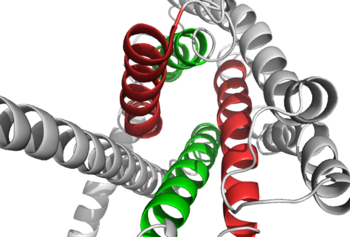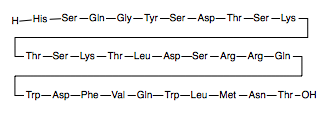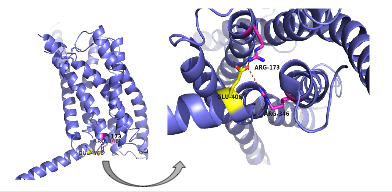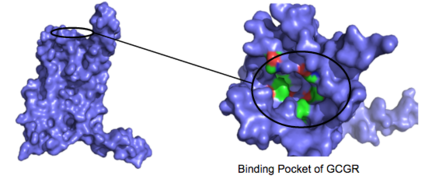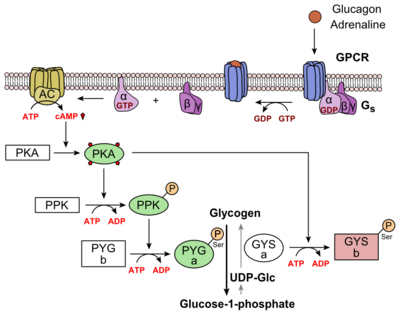Sandbox Reserved 1165
From Proteopedia
(Difference between revisions)
| Line 33: | Line 33: | ||
For glucagon to initiate the breakdown of [https://en.wikipedia.org/wiki/Glycogen glycogen] into glucose, it follows a specific [https://en.wikipedia.org/wiki/Glucagon signaling mechanism] (Figure 6). Glucagon binds to a G protein-coupled receptor located on the [https://en.wikipedia.org/wiki/Cell_membrane plasma membrane], and this binding induces a [https://en.wikipedia.org/wiki/Conformational_change conformational change] that activates G proteins which exchanges a [https://en.wikipedia.org/wiki/Guanosine_diphosphate guanosine diphosphate (GDP]) for guanosine [https://en.wikipedia.org/wiki/Guanosine_triphosphate triphosphate (GTP)] that is bound to the [https://en.wikipedia.org/wiki/G_alpha_subunit alpha subunit]. Now with the GTP in place, the activated alpha subunit leaves the [https://en.wikipedia.org/wiki/Heterotrimeric_G_protein heterotrimeric G protein] and activatesthe next [https://en.wikipedia.org/wiki/Enzyme enzyme] in the cascade, [https://en.wikipedia.org/wiki/Adenylyl_cyclase adenylate cyclase]. Once adenylate cyclase is activated, it catalyzes the conversion of [https://en.wikipedia.org/wiki/Adenosine_triphosphate adenosine triphosphate (ATP)] into cyclic [https://en.wikipedia.org/wiki/Cyclic_adenosine_monophosphate adenosine monophosphate (cAMP)]. This in turn activates [https://en.wikipedia.org/wiki/Protein_kinase_A protein kinase A (PKA)] that then activates [https://en.wikipedia.org/wiki/Phosphorylase_kinase phosphorylase kinase]. Finally, the phosphorylase kinase [https://en.wikipedia.org/wiki/Phosphorylation phosphorylates] [https://en.wikipedia.org/wiki/Glycogen_phosphorylase glycogen phosphorylase b] that is then turned into its activated form, glycogen phosphorylase a. This phosphorylase A enzyme is responsible for catalyzing the release of [https://en.wikipedia.org/wiki/Glucose_1-phosphate glucose-1-phosphate] into the bloodstream from glycogen [https://en.wikipedia.org/wiki/Polymer polymers]. | For glucagon to initiate the breakdown of [https://en.wikipedia.org/wiki/Glycogen glycogen] into glucose, it follows a specific [https://en.wikipedia.org/wiki/Glucagon signaling mechanism] (Figure 6). Glucagon binds to a G protein-coupled receptor located on the [https://en.wikipedia.org/wiki/Cell_membrane plasma membrane], and this binding induces a [https://en.wikipedia.org/wiki/Conformational_change conformational change] that activates G proteins which exchanges a [https://en.wikipedia.org/wiki/Guanosine_diphosphate guanosine diphosphate (GDP]) for guanosine [https://en.wikipedia.org/wiki/Guanosine_triphosphate triphosphate (GTP)] that is bound to the [https://en.wikipedia.org/wiki/G_alpha_subunit alpha subunit]. Now with the GTP in place, the activated alpha subunit leaves the [https://en.wikipedia.org/wiki/Heterotrimeric_G_protein heterotrimeric G protein] and activatesthe next [https://en.wikipedia.org/wiki/Enzyme enzyme] in the cascade, [https://en.wikipedia.org/wiki/Adenylyl_cyclase adenylate cyclase]. Once adenylate cyclase is activated, it catalyzes the conversion of [https://en.wikipedia.org/wiki/Adenosine_triphosphate adenosine triphosphate (ATP)] into cyclic [https://en.wikipedia.org/wiki/Cyclic_adenosine_monophosphate adenosine monophosphate (cAMP)]. This in turn activates [https://en.wikipedia.org/wiki/Protein_kinase_A protein kinase A (PKA)] that then activates [https://en.wikipedia.org/wiki/Phosphorylase_kinase phosphorylase kinase]. Finally, the phosphorylase kinase [https://en.wikipedia.org/wiki/Phosphorylation phosphorylates] [https://en.wikipedia.org/wiki/Glycogen_phosphorylase glycogen phosphorylase b] that is then turned into its activated form, glycogen phosphorylase a. This phosphorylase A enzyme is responsible for catalyzing the release of [https://en.wikipedia.org/wiki/Glucose_1-phosphate glucose-1-phosphate] into the bloodstream from glycogen [https://en.wikipedia.org/wiki/Polymer polymers]. | ||
| - | [[Image:Glucagon_Pathway.png|(|):|400 px|center|thumb|'''Figure 6: Glucagon Signaling Pathway''']] | + | [[Image:Glucagon_Pathway.png|(|):|400 px|center|thumb|'''Figure 6: [https://en.wikipedia.org/wiki/Glucagon Glucagon Signaling Pathway]''']] |
=Clinical Relevancy= | =Clinical Relevancy= | ||
Revision as of 16:53, 30 March 2016
References
- ↑ 1.0 1.1 Hollenstein K, de Graaf C, Bortolato A, Wang MW, Marshall FH, Stevens RC. Insights into the structure of class B GPCRs. Trends Pharmacol Sci. 2014 Jan;35(1):12-22. doi: 10.1016/j.tips.2013.11.001. Epub, 2013 Dec 18. PMID:24359917 doi:http://dx.doi.org/10.1016/j.tips.2013.11.001
- ↑ 2.0 2.1 2.2 2.3 2.4 2.5 Siu FY, He M, de Graaf C, Han GW, Yang D, Zhang Z, Zhou C, Xu Q, Wacker D, Joseph JS, Liu W, Lau J, Cherezov V, Katritch V, Wang MW, Stevens RC. Structure of the human glucagon class B G-protein-coupled receptor. Nature. 2013 Jul 25;499(7459):444-9. doi: 10.1038/nature12393. Epub 2013 Jul 17. PMID:23863937 doi:10.1038/nature12393
- ↑ 3.0 3.1 Miller LJ, Dong M, Harikumar KG. Ligand binding and activation of the secretin receptor, a prototypic family B G protein-coupled receptor. Br J Pharmacol. 2012 May;166(1):18-26. doi: 10.1111/j.1476-5381.2011.01463.x. PMID:21542831 doi:http://dx.doi.org/10.1111/j.1476-5381.2011.01463.x
- ↑ Thomsen J, Kristiansen K, Brunfeldt K, Sundby F. The amino acid sequence of human glucagon. FEBS Lett. 1972 Apr 1;21(3):315-319. PMID:11946536
- ↑ Bortolato A, Dore AS, Hollenstein K, Tehan BG, Mason JS, Marshall FH. Structure of Class B GPCRs: new horizons for drug discovery. Br J Pharmacol. 2014 Jul;171(13):3132-45. doi: 10.1111/bph.12689. PMID:24628305 doi:http://dx.doi.org/10.1111/bph.12689
- ↑ Mukund S, Shang Y, Clarke HJ, Madjidi A, Corn JE, Kates L, Kolumam G, Chiang V, Luis E, Murray J, Zhang Y, Hotzel I, Koth CM, Allan BB. Inhibitory mechanism of an allosteric antibody targeting the glucagon receptor. J Biol Chem. 2013 Nov 4. PMID:24189067 doi:http://dx.doi.org/10.1074/jbc.M113.496984
- ↑ Hoare SR. Allosteric modulators of class B G-protein-coupled receptors. Curr Neuropharmacol. 2007 Sep;5(3):168-79. doi: 10.2174/157015907781695928. PMID:19305799 doi:http://dx.doi.org/10.2174/157015907781695928
- ↑ 8.0 8.1 8.2 Yang L, Yang D, de Graaf C, Moeller A, West GM, Dharmarajan V, Wang C, Siu FY, Song G, Reedtz-Runge S, Pascal BD, Wu B, Potter CS, Zhou H, Griffin PR, Carragher B, Yang H, Wang MW, Stevens RC, Jiang H. Conformational states of the full-length glucagon receptor. Nat Commun. 2015 Jul 31;6:7859. doi: 10.1038/ncomms8859. PMID:26227798 doi:http://dx.doi.org/10.1038/ncomms8859
